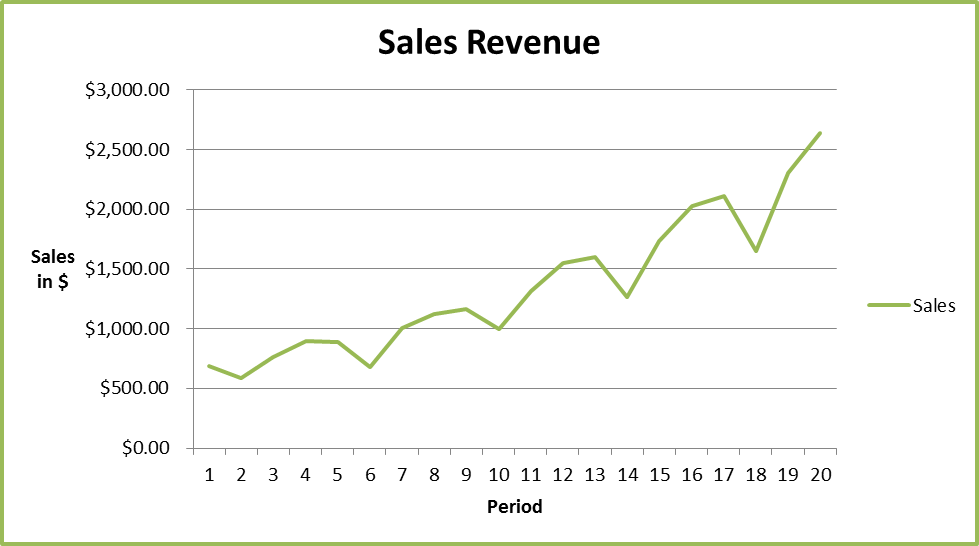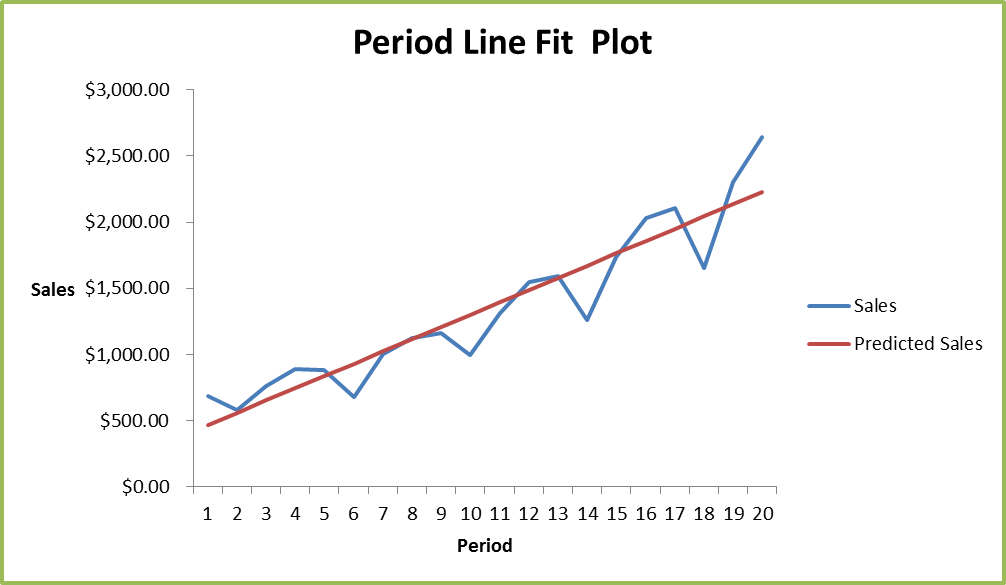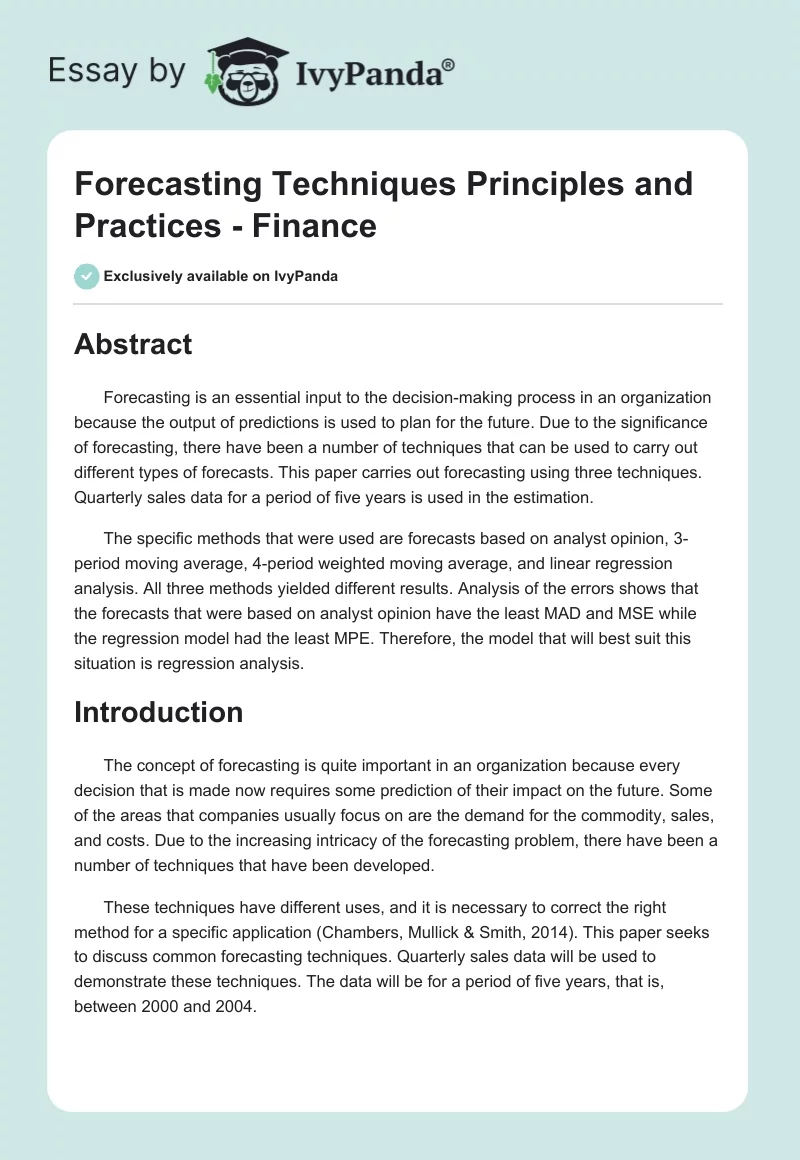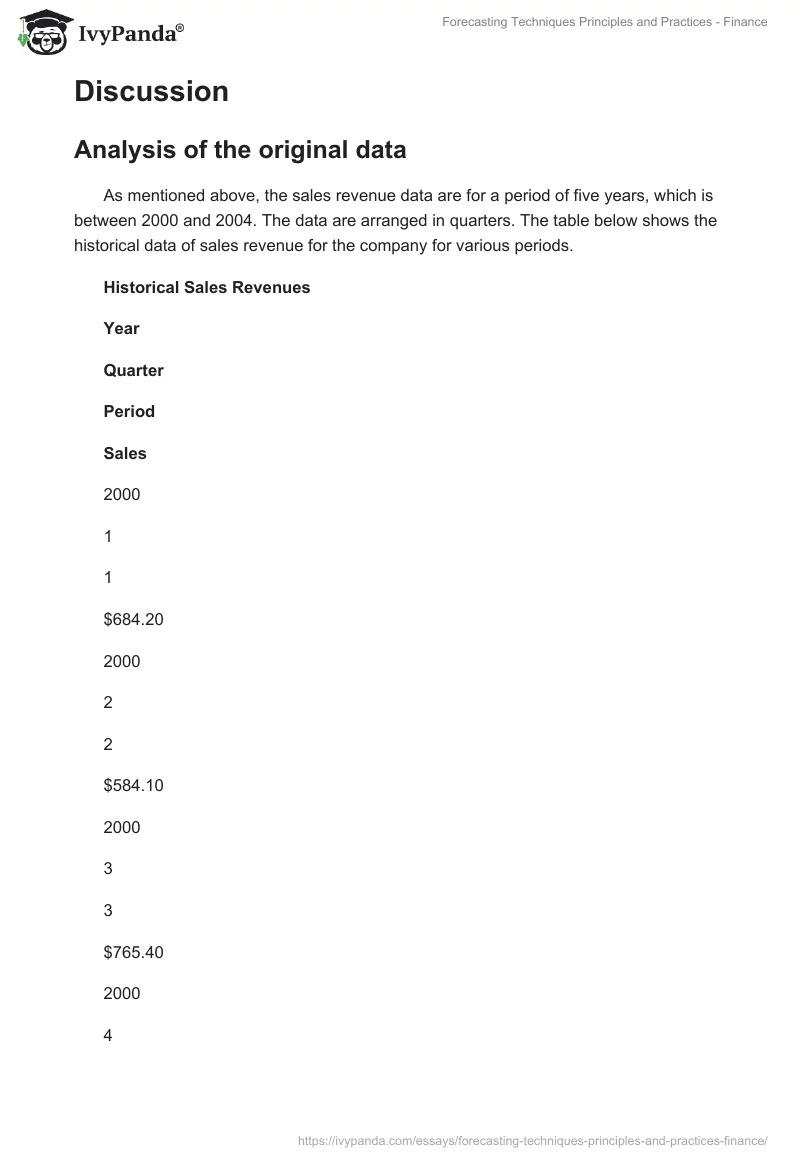Abstract
Forecasting is an essential input to the decision-making process in an organization because the output of predictions is used to plan for the future. Due to the significance of forecasting, there have been a number of techniques that can be used to carry out different types of forecasts. This paper carries out forecasting using three techniques. Quarterly sales data for a period of five years is used in the estimation.
The specific methods that were used are forecasts based on analyst opinion, 3-period moving average, 4-period weighted moving average, and linear regression analysis. All three methods yielded different results. Analysis of the errors shows that the forecasts that were based on analyst opinion have the least MAD and MSE while the regression model had the least MPE. Therefore, the model that will best suit this situation is regression analysis.
Introduction
The concept of forecasting is quite important in an organization because every decision that is made now requires some prediction of their impact on the future. Some of the areas that companies usually focus on are the demand for the commodity, sales, and costs. Due to the increasing intricacy of the forecasting problem, there have been a number of techniques that have been developed.
These techniques have different uses, and it is necessary to correct the right method for a specific application (Chambers, Mullick & Smith, 2014). This paper seeks to discuss common forecasting techniques. Quarterly sales data will be used to demonstrate these techniques. The data will be for a period of five years, that is, between 2000 and 2004.
Discussion
Analysis of the original data
As mentioned above, the sales revenue data are for a period of five years, which is between 2000 and 2004. The data are arranged in quarters. The table below shows the historical data of sales revenue for the company for various periods.
The table shows that there has been a general increase in the sales revenue for the company for the five year period. However, the revenue generated from sales is cyclic, that is, it is low during the second quarter and increased gradually in the third, fourth, and the first quarter for all the years. The graph below shows the trend in sales revenue for the 20 periods in the five year period.

The data on sales in quarters are presented below.
Forecasting techniques
There exist three basic categories of forecasting techniques. The three techniques are qualitative techniques, time series analysis and projections, and casual models. These three techniques use different approach to predict future values and they are discussed in the subsequent section.
Qualitative techniques
This technique is based on judgments and views of experts and available information on special occasions. This may or may not take into account historical trends. The data can be obtained through a number of ways. The first approach is by informing the salespersons to gather the sales data for different categories and time periods. Secondly, it is by getting the information from different employees at different levels. The third approach is by conducting customer surveys.
The customers can be contacted via a phone call or by using forms (Sandford & Hsu, 2007). The final way of obtaining such data is monitoring the sales of other related products such as complements and substitutes. A review of the opinions of the analysts shows that the sales value of the commodity will continue to rise in the same trend (Hyndman & Athanasopoulos, 2014). The table presented below shows the forecasted sales values using analysts’ opinions.
Time series analysis and projections
Time series analysis makes use of the historical data to predict future values. The most common techniques that can be used under this category are moving average, linear regression analysis, trend estimation, growth curves, and exponential smoothing (Madura, 2014). Under this category, two methods will be used. They are discussed below.
3-period moving average
The table presented below shows results for the three-period moving average.
4-period weighted moving average
The table presented below shows results for the four-period weighted moving average.
Causal models
This category makes use of extremely advanced and exact information about the association between the variables. These models take into account particular occasions. In this case, the regression model will be used.
Linear regression model
Regression analysis is a statistical tool that is used to develop approximate linear relationships among various variables. Regression analysis formulates an association between several variables. There are a number of variables that can affect the sales revenue of a company. Some of the factors are the price of the products of the company, competition, news about the company, and the amount spent on advertising, among other factors.
When coming up with the simple linear regression model, it is necessary to separate between dependent and independent variables (Wang, 2010). In this scenario, the dependent variable is the sales revenue, while the independent variable is the time period.
The regression line will take the form Y = b0 + b1X
Y = Sales revenue
X = Time
The theoretical expectations are b0 can take any value and b1 > 0 (positive).
Regression Results
From the above table, the regression equation can be written as Y = 375.1758 + 92.62564X. The intercept value of 375.1758 represents other variables that affect the average sales revenue but are not included in the modeling. The coefficient value of 92.62564 implies that as time increases by one unit, the sales revenue increases by 92.6256 units. When the regression equation is compared with the scatter diagram, there is an indication of consistency.
The graph of average sales revenue and time shows an upward trend with a correlation coefficient of 0.9341. The regression equation above also yields a positive slope. The p-value for t-statistic is greater than α = 0.05. This shows that the variable is statistically significant. The overall regression line is also significant, as indicated by significance f in the ANOVA analysis.
Finally, the time period explains significant variations in the variation of sales, as indicated by the value of R-Square and adjusted R-Square. Thus, it is clear that the regression equation is sensible and can be used for forecasting. The graph below shows the graph of the original plots of sales revenue and time with a line of best fit.

The table presented below shows the forecasted values of sales using the estimated regression model.
Evaluation of errors
In this section, three methods will be used to evaluate the errors in the forecasting techniques used in the subsequent sections.
Mean absolute deviation (MAD)
The results of the three methods are presented below.
Qualitative techniques
Time series analysis and projections
3-period moving average
4-period weighted moving average
Causal models
Linear regression model
In the above results, it can be noted that the qualitative method has the least MAD. Therefore, it will be preferred to the other methods.
Mean squared error (MSE)
Qualitative techniques
Time series analysis and projections
3-period moving average
4-period weighted moving average
Causal models
Linear regression model
In the above results, it can be noted that the qualitative method has the least MSE. Therefore, it will be preferred to the other methods.
Mean percentage error (MPE)
Qualitative techniques
Time series analysis and projections
3-period moving average
4-period weighted moving average
Causal models
Linear regression model
In the above results, it can be noted that linear regression analysis has the least MSE. Therefore, it will be preferred to the other methods.
Conclusion
This paper carries out forecasting using three techniques; these are forecasts based on analyst opinion, 3-period moving average, 4-period weighted moving average, and linear regression analysis. The model that will be the most suitable in this scenario is a regression analysis because it has the least MPE, and it is also comprehensive.
References
Chambers, J., Mullick, S., & Smith, D. (2014). How to choose the right forecasting technique. Web.
Hyndman, R., & Athanasopoulos, G. (2014). Forecasting: principle and practice. USA: Otext.com.
Madura, J. (2014). International financial management. USA: Cengage Learning.
Sandford, B., & Hsu, C. (2007). The Delphi technique: making sense of consensus. Practical Assessment and Research Evaluation, 12(10), 1-8.
Wang, J. (2010). Business intelligence in economic forecasting: technologies and techniques. USA: IGI Global.


